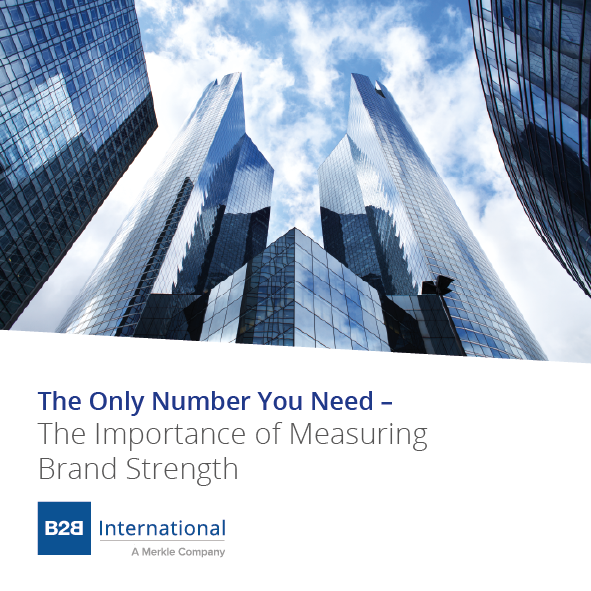Introduction
Brands are more important now than ever before! Brands are a promise to your buyer and in a world of uncertainty a powerful brand conveys credibility, trustworthiness, integrity, quality, reliability and experience. Brands are valuable and can often be the differentiator in a commoditized or undifferentiated B2B market.
Therefore, if you are going to make a change to your brand you need to be confident in the changes you are going to make.
This quote is something we frequently hear from conversations we have with our C-Suite clients:
“If we need to make changes to the way we do things that’s absolutely fine, but show me the numbers to prove it!”
‘Big’ decisions, be they operational or strategic in nature, are rarely made on a whim or based on gut-feeling alone and typically need to be evidenced and rationalized before approval is given and resources allocated.
As well as being based on large, robust samples with high degrees of statistical confidence and therefore the reassurance that they are in fact correct, a desire for a single number or metric is frequently driven by an organization or management’s need for:
- Clarity (ease of understanding)
- Consistency (ability to measure and track over time)
- Comparability (to assess similarities or differences between markets, segments or types of customers)
There are many widely accepted and proven metrics in the world of market research – the NPS is perhaps the best known as a measure of customer loyalty and it is unquestionably clear, consistent and comparable. However, brand strength is maybe not as widely known but a metric that is just as important and could be argued as even more important. Let us introduce The Brand Strength Score to you…
Measuring the Performance of a Brand
Creating a single metric is arguably more straightforward where the subject is something tangible i.e. customer satisfaction with an experience or interaction, overall feeling towards a supplier, ease of working with a supplier or recall of a company name. But when it comes to brands and specifically assessing the wider performance of a brand or its strength in a market, there are many different aspects that need to be considered and typically, each is measured using separate metrics. For example, a typical brand assessment study will likely include:
-
Brand funnel – to measure how well awareness is converted into usage or preference
-
Recommendation (NPS) – assessing ‘loyalty’ or advocacy
-
Unprompted brand associations – understanding what aspects of a brand are most recalled
-
Brand perceptions – measurement of a series of values, characteristics or desired associations
-
Communications recall and reaction – extent to which activities are recalled and recognized
Although these different measures are highly correlated and should be interpreted in conjunction with one another, distilling the wealth of information from these multiple data points into a single, reportable measure or metric is difficult. Which elements of each should be included and how do they work together to create a strong brand?
In answering these questions and ultimately deriving a single metric that can be used as a yardstick for measuring a brand’s strength, we need to consider a number of factors:
-
To create buy-in, support and ultimately ensure that action is taken, any metric must be based on elements (inputs) that can clearly be shown to impact the wider business objective or strategy i.e. we must be measuring something that matters
-
To further generate support for such a metric and to aid efficiency or understanding and implementation, the metric should be familiar in make-up to those who will be using it i.e. it must be based on elements that are already recognized, measured and tracked rather than generating additional data points
-
Remaining consistent (and potentially being applicable to past data that has been collected) to allow like-forlike tracking over time is also important i.e. any metric must have mid to long-term use to ensure that ‘real’ movements over time and the effect of actions taken can be seen
-
Encompassing elements that are applicable and relevant to all audiences or sub-groups of interest is fundamental to enable ‘fair’ comparisons to be made i.e. being able to compare and contrast audiences such as geography or industry sector on a ‘level playing field’
The Brand Strength Score
Considering these factors and the long-held need for a single measure of brand performance, B2B International has developed an approach that allows organizations to measure Brand Strength in a way that:
-
is tailored to their own strategic objectives and goals
-
is based on recognized and robust statistical techniques
-
provides clear direction on which areas to focus on to improve competitive performance
In creating the Brand Strength metric, we follow a number of pre-defined steps;
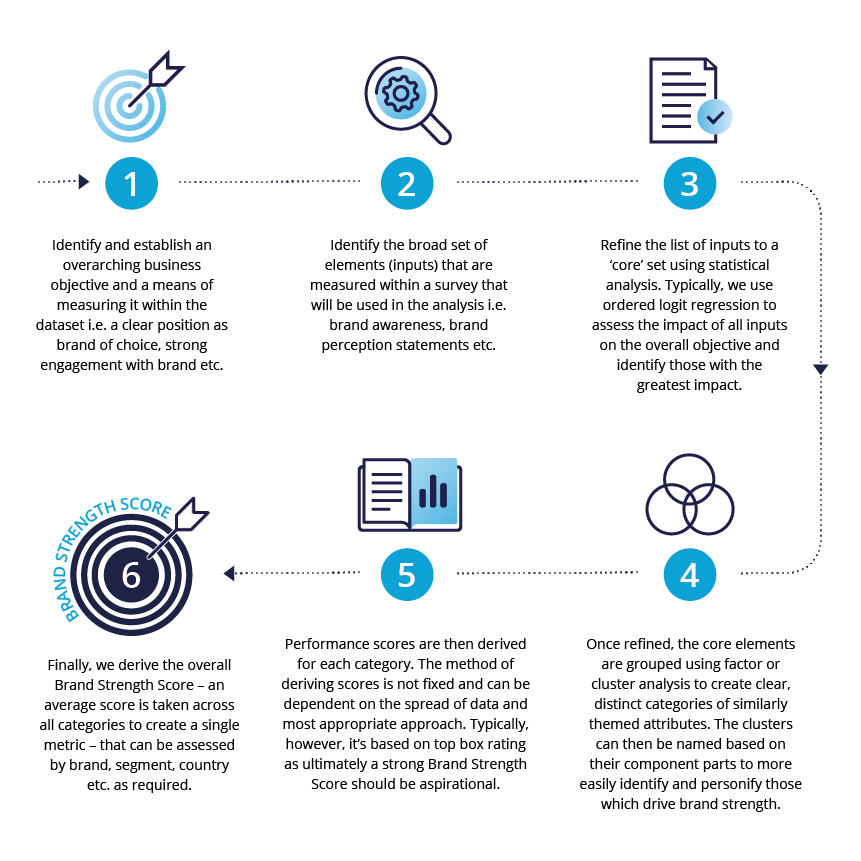
What Does it Look Like?
The flexibility and tailored nature of Brand Strength means that the way in which it is presented is not set in stone and can be adapted to suit individual preferences. The core principle is that the different categories feed into the overall metric and the following are example representations;
Example 1
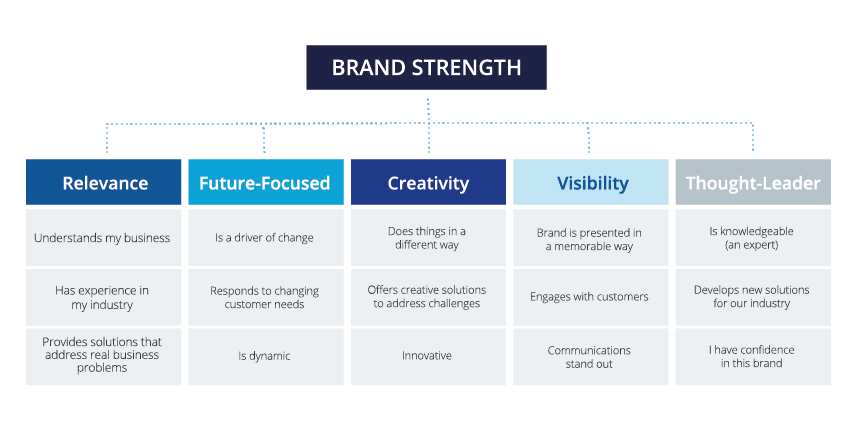
Example 2
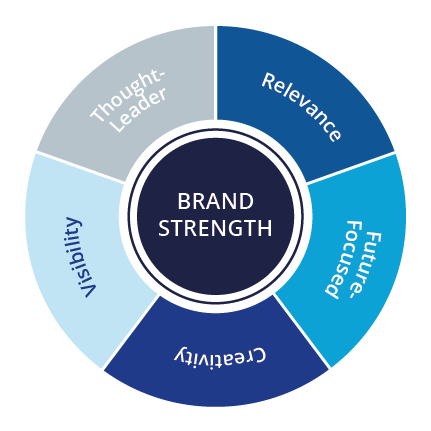
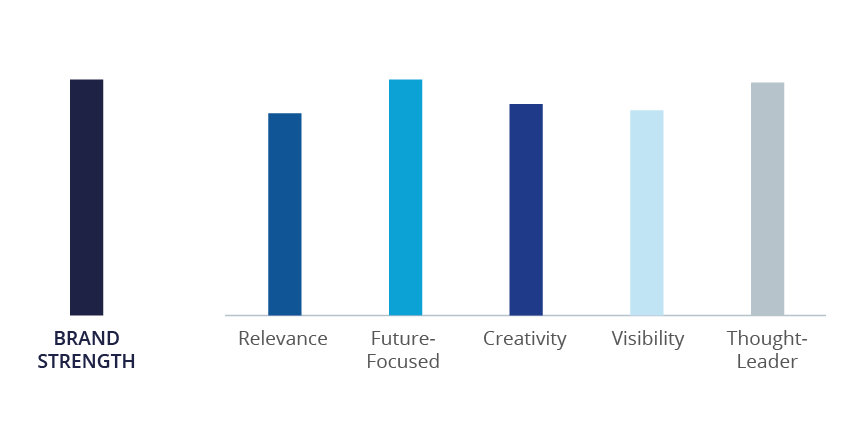
Advantages of Brand Strength
The value in this single measure of Brand Strength is its ability to address the earlier mentioned challenges of combining multiple inputs and understanding their relation to one another. To reiterate, once the measurement has been established it allows an organization to;
-
Report a single and robust measure of performance that is grounded in an overall business objective
-
Compare and contrast performance across the organization i.e. by geography, business unit, subsets of target customers to identify variations in performance (both overall and within the component elements)
-
Measure performance against key competitors to identify where strengths exist (to communicate and differentiate) and where focus may be needed (to improve performance) – provided that competitor data is collected
-
Consistently track performance over time providing like-for-like comparison to assess or measure the impact of actions taken
Considerations When Using Brand Strength
As with all metrics and frameworks, there are some considerations to be mindful of;
The metric is reliant on the quality and breadth of its component elements – care is needed to ensure that those elements being tracked sufficiently cover and represent what the organization is looking to achieve (i.e. desired brand values and positioning). And also that they provide direction in terms of what may need to be actioned to improve performance i.e. they go beyond simply being ‘generic’ attributes
![]()
To provide robust, directional results requires relatively large sample sizes so where measurement is needed by sub-group, sufficient volumes of data must be available for each
Where competitive performance needs to be measured, it is important to ensure an appropriate spread of competitors within the data collection i.e. is the focus on large global brands only or is a wider spread including regional or local brands required; and are niche or up-and-coming/disrupter brands to be included?
Adapting the Model Over Time
A final note on The Brand Strength Score is to acknowledge a common challenge in all tracking and measurement studies – how to remain relevant over time. By that we are concerned with how to accommodate changes in market needs or dynamics and reflect them in attributes or desired brand characteristics. It is inevitable that over time, new elements will be added to a tracking study and this raises the question of how and whether these should be reflected in The Brand Strength model.
One approach is to derive the component elements once (in year 1) and then continue to track these year-on-year to ensure a consistent measurement. The benefit here is that it requires little adjustment from year to year which builds familiarity with the component elements. Additionally, the statistical analysis is conducted only once – making it more cost and time efficient to develop and track. This approach would likely be recommended in mature/established markets where minimal change or disruption is expected and key market drivers are well-known and unlikely to change.
Alternatively, where markets are more dynamic or emerging and therefore prone to change, it is likely that the drivers of choice, preference etc. will change – either in response to shifting customer expectations, changes in demand or supplier initiatives or innovation. In these cases, there may be greater need for The Brand Strength model to adapt and ensure that the component elements are accurately reflecting the market drivers. In such cases, the metric may need to be re-run (annually or bi-annually) to ensure it is always derived from the most important elements and reflects what is truly driving choice/engagement etc.
Whilst this approach will reflect changing market dynamics and allows the inclusion of new elements if desired, it will add cost/time to any analysis and may require additional effort to educate and familiarize internal stakeholders of the process and how to interpret the results. That said, they may be placated with the explanation that the single metric is reflective of market drivers.
To Conclude
Whether you have existing brand health tracking research in place or are looking to develop a program to track performance, B2B International has extensive experience with leading-global organizations and our consultants are available to discuss a wide array of possible approaches. Building on the more commonly accepted measures such as brand funnel and attribute association to develop a clear understanding of Brand Strength may be one such approach to consider.
For more information please contact your local B2B International office.
Readers of this article also viewed:
- Running a Successful Brand Tracking Programme
- A Guide to Measuring Brand Health
- B2B Branding: How to Build a Brand in Business-to-Business Markets




